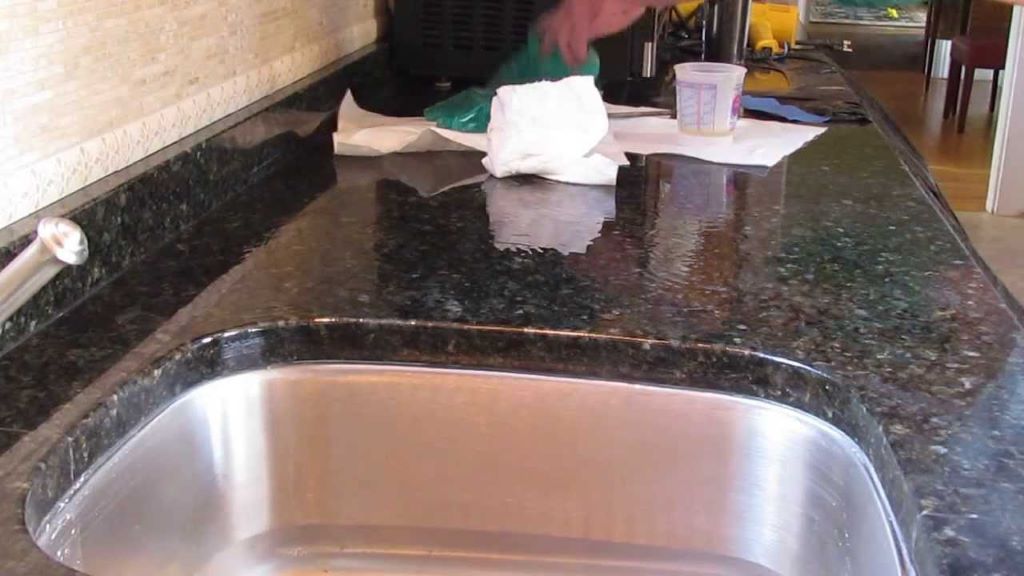Granite countertops are prized for their elegance, durability, and timeless style. However, even this resilient stone isn’t immune to wear and tear. Accidents happen – chips, cracks, and etches can blemish your gorgeous countertop over time. Fear not, though – many of these issues are repairable with a little DIY skill and the right materials.
This article will walk you through common granite countertop problems and offer practical solutions for fixing them at home.
Disclaimer: For extensive damage, always consult a professional for the most seamless and durable repair.
Common Granite Countertop Problems and How to Repair Them
1. Chips
- Identifying the issue: Chips are small pieces missing from the edge or surface of your countertop. They might occur from dropping a heavy object or bumping the counter’s edge.
- Materials you’ll need:
- Color-matched granite epoxy kit
- Sandpaper (several grits, from coarse to fine)
- Razorblade
- Acetone
- Masking tape
- Repair steps:
-
- Clean the area: Thoroughly clean the chipped area and surrounding surface with acetone to remove any dirt or debris.
- Mix the epoxy: Follow the instructions on your epoxy kit to mix the resin and hardener. Tint the epoxy to match your countertop’s color as closely as possible.
- Fill the chip: Overfill the chip slightly with the tinted epoxy, as it tends to shrink a bit as it dries.
- Let it cure: Allow the epoxy to cure completely according to the manufacturer’s instructions. This usually takes at least 24 hours.
- Sand and polish: Once cured, use sandpaper (starting with coarse and working down to fine grit) to sand the epoxy flush with the countertop. A wet sanding technique will help reduce dust.
- Clean up: Remove any excess epoxy with a razor blade and clean with acetone. You can enhance the shine with a granite-specific polish.
Related: The Ultimate Guide to Kitchen Remodeling on a Budget
2. Cracks:
- Identifying the issue: Cracks in granite can be either hairline fissures or more obvious splits. Hairline fissures are often superficial and pose little structural risk, while larger cracks may require professional reinforcement.
- Materials needed
- Color-matched granite epoxy kit
- Sandpaper (several grits, from coarse to fine)
- Razorblade
- Acetone
- Masking tape (optional, for large cracks)
- Repair steps:
-
- Clean and prepare: Clean the crack thoroughly with acetone. For larger cracks, use masking tape around the crack to contain the epoxy.
- Mix and fill: Prepare the epoxy kit according to instructions, color-matching it to your granite. Carefully fill the crack with epoxy.
- Cure: Allow the epoxy to cure completely.
- Sanding and polishing: Sand the repaired area, ensuring it’s level with the countertop and remove excess epoxy with a razor blade. Clean and optionally polish.
3. Etches:
- Identifying the issue: Etches appear as dull spots or rings on your granite countertops. They occur from exposure to acidic substances like lemon juice or vinegar. Etches aren’t physical damage, but a change in the polish.
- Materials you’ll need:
- Granite poultice powder
- Granite polish
- Soft cloths
- Repair steps:
-
- Apply poultice: Mix the poultice powder with water to create a paste-like consistency. Apply generously to the etch and cover with plastic wrap. Let it sit for 24-48 hours as directed on the product.
- Remove and polish: Remove the dried poultice and clean the area. Apply granite polish and buff with a soft cloth for restored shine.
Tips for a Successful Repair
- Color matching: Do your best to match the epoxy with your counter’s color. Consider buying a kit with multiple pigments for better customization.
- Practice first: If you’re unsure of your skills, test your epoxy and tinting technique on a spare piece of granite or an inconspicuous area.
- Be patient: Epoxy takes time to cure fully. Don’t rush the process.
- Prevention is key Use cutting boards, coasters, and trivets to protect your counter from scratches, acidic spills, and heat damage.
When to Call a Professional
- Large chips and cracks: Big repairs are best handled by pros for a seamless result.
- Structural issues: If a crack signifies potential weakening of your countertop, consult an expert.
- Extensive or recurring etches: This could signal that your countertop sealant has deteriorated and needs professional re-sealing.
With care, patience, and the right tools, you can repair many granite countertop mishaps and keep your kitchen looking its best.





Leave a Reply